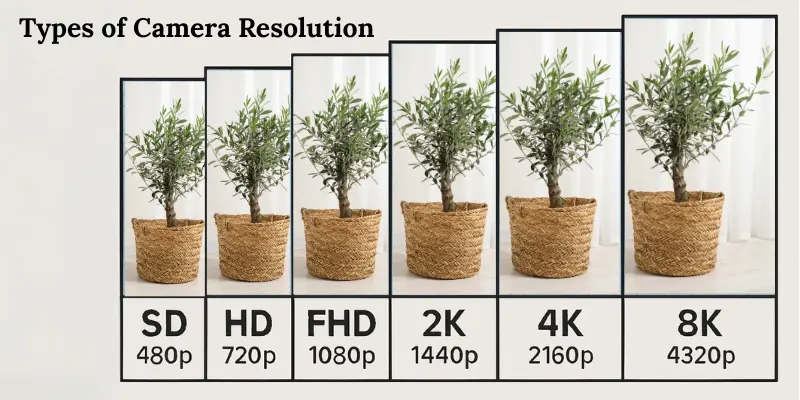What Is Camera Resolution? A Beginner-Friendly Guide
Published: 6 Aug 2025
When it comes to photography and videography, one term that’s frequently mentioned is camera resolution. Whether you’re buying a new smartphone or a professional camera, understanding camera resolution helps you get better photos and videos.
In this guide, we’ll explain what is camera resolution, how it works, and how it affects image quality. Whether you’re just starting out or already have some experience, this guide will help you make the right camera choice. Let’s get started!
What is Camera Resolution?
Camera resolution refers to the amount of detail a camera can capture in a photo or video. It’s usually measured in megapixels (MP). One megapixel equals one million tiny dots, or pixels, that make up an image. A pixel is the smallest unit of a digital image, and more pixels generally mean better detail. For example, a 12 MP camera captures 12 million pixels in each image.
In simpler terms, the higher the resolution, the more detail the image will have. This is especially important when you want to zoom in, crop, or print your photos in large sizes without losing clarity. But resolution isn’t everything. Image quality also depends on other things, like the size of the camera sensor and the lens you’re using.
How Camera Resolution Works
Camera resolution works through the camera’s sensor, which is responsible for capturing light and turning it into an image. The resolution of the camera sensor determines how many individual pixels can be recorded in an image.
Each pixel in the image captures a small portion of the light that passes through the lens. The more pixels a camera has, the more detailed the image can be, as each pixel can capture more information.
However, it’s important to note that higher resolution doesn’t always mean better quality. Other factors, such as sensor size, lens quality, and image processing, also affect the overall quality of the image. A high-resolution sensor in a small camera with a poor lens might not perform as well as a lower-resolution sensor with a higher-quality lens and a larger sensor.
In short, camera resolution works by capturing more pixels with better detail, but it should be considered alongside other features for the best image quality.
Types of Camera Resolution
Camera resolution is often measured in megapixels (MP), but it varies across devices, from basic to professional. Here’s a quick look at the main types and their uses.

1. Standard Definition (SD) – 480p
SD has a resolution of 640 × 480 pixels. It was common in old TVs and basic security cameras. Today, it feels outdated and lacks the clarity needed for modern photo or video use.
2. High Definition (HD) – 720p
With 1280 × 720 pixels, HD is sharper than SD and is still used in older smartphones and basic webcams. It’s okay for casual use, but not ideal for clear, detailed images or videos.
3. Full HD (FHD) – 1080p
FHD offers 1920 × 1080 pixels and is widely used in webcams, budget cameras, and YouTube videos. It delivers sharp quality and is great for everyday use, like video calls, vlogging, and streaming.
4. Quad HD (2K) – 1440p
2K resolution (2560 × 1440 pixels) offers better detail than 1080p. It’s popular in gaming monitors and premium smartphones, giving sharper visuals without being as heavy as 4K.
5. Ultra HD (4K) – 2160p
4K resolution (3840 × 2160 pixels) provides great sharpness and detail. It’s used in modern TVs, pro-level cameras, and video editing, especially when high clarity is needed on large screens.
6. 8K – 4320p
8K displays 7680 × 4320 pixels. It provides ultra-clear pictures, mostly used in high-end filmmaking and large digital displays. But it’s not suitable for daily use due to big file sizes and high costs.
How Does Camera Resolution Affect Image Quality?
Camera resolution is an important factor in determining the level of detail in your photos and videos. Here’s how it affects key parts of image quality:
- Sharper images with more detail: Higher resolution captures more pixels, resulting in clearer, more detailed images.
- Better zooming without losing quality: Higher resolution allows you to zoom in or crop without losing clarity or sharpness.
- Clearer prints in larger sizes: A higher resolution allows you to print bigger images without them looking blurry or pixelated.
- More editing flexibility: Higher resolution offers more pixels for adjustments like cropping or exposure changes without losing image quality.
How to Choose the Right Camera Resolution for Different Needs
Choosing the right camera resolution depends on how you plan to use your photos or videos. Here’s a quick overview to help you decide:
- For Everyday Use: If you’re taking casual photos or using your camera for social media, a 12–16 MP camera is more than enough.
- For Printing: Planning to print large photos? Choose 20 MP or higher to keep your prints sharp and detailed.
- For Cropping and Editing: If you often crop or zoom in while editing, choose a camera with 24 MP+ resolution, so you don’t lose quality when adjusting your image.
- For Low-Light or Night Shots: Sometimes, a lower-resolution sensor with a larger sensor size performs better in low light than a high-resolution camera. Consider this if you’re shooting in challenging lighting conditions.
- For Video Recording: Resolution matters for video as well. Choose a camera with at least 1080p (Full HD) or 4K for clearer, more detailed video.
- For Professional Work: Photographers or content creators might need 30 MP or higher, depending on their specific needs (e.g., fashion, landscape, or product photography).
Common Misconceptions About Camera Resolution
When it comes to camera resolution, there are a few myths that can confuse even experienced photographers. Let’s clear up some of the most common misconceptions:
1. “Higher Resolution Always Means Better Quality”
A higher resolution doesn’t always mean better photo quality. Other factors like the size of the sensor, the quality of the lens, and how the camera processes the image are just as important.
For example, a 12 MP camera with a good lens and a large sensor can take better photos than a 40 MP camera with a small sensor and a low-quality lens.
2.”If the Image Pixelates on Zoom, the Camera is Bad”
This is a common misconception. Pixelation often occurs when zooming into low-resolution images or compressed files, but it doesn’t necessarily mean the camera is bad.
Sometimes, the quality loss is due to software compression or the distance from the subject. Even high-resolution cameras can pixelate if the image is enlarged too much.
3. “High-Resolution Cameras Don’t Need Editing”
Even with high-resolution cameras, editing is often required to improve color, contrast, or sharpness. A high-resolution image gives you more room to edit, but it doesn’t mean you can skip editing completely.
Conclusion
So guys, in this article, we’ve covered what is camera resolution in detail. Understanding the importance of resolution helps you choose the right camera for your needs, whether it’s for casual use or professional work. My personal recommendation is to always balance resolution with other features like sensor size and lens quality to get the best results. If you’re planning to buy a new camera, take your time to research and pick one that suits your specific requirements.
Do you have any confusion or questions about camera resolution? Feel free to share them in the comments below – I’m here to help!
Frequently Asked Questions (FAQs)
Here are answers to some of the most common questions about what camera resolution is :
Camera resolution is the amount of detail a camera can capture in a photo or video. It’s measured in megapixels (MP), where 1 MP = 1 million pixels. More pixels usually mean a sharper and more detailed image.
A good phone camera usually has between 12 MP and 50 MP, depending on your needs. For everyday photos, 12–16 MP with a good sensor is more than enough. Higher MP phones are great for zooming or cropping, but image quality also depends on the lens and software.
For home use, a 1080p (Full HD) security camera is usually enough. If you need clearer footage or want to zoom in on faces or license plates, consider 2K or 4K resolution. Higher resolution gives more detail but also uses more storage.
1080p (Full HD) is great for most YouTube videos. If you want super sharp quality or plan to zoom in, 4K is even better. But keep in mind, 4K files are larger and take longer to upload.

- Be Respectful
- Stay Relevant
- Stay Positive
- True Feedback
- Encourage Discussion
- Avoid Spamming
- No Fake News
- Don't Copy-Paste
- No Personal Attacks

- Be Respectful
- Stay Relevant
- Stay Positive
- True Feedback
- Encourage Discussion
- Avoid Spamming
- No Fake News
- Don't Copy-Paste
- No Personal Attacks





